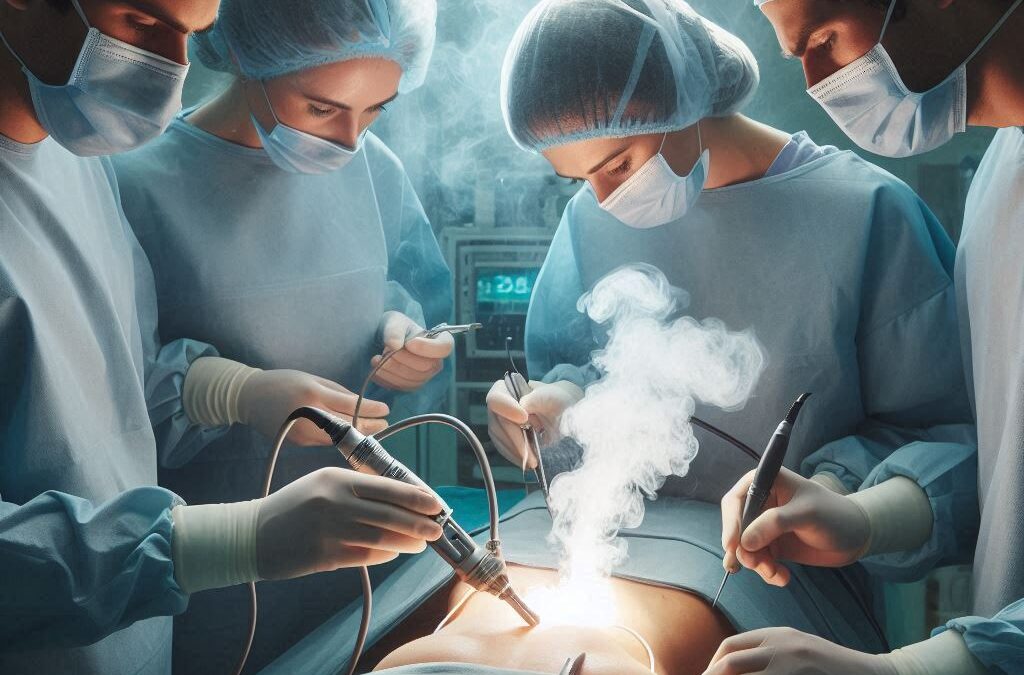As the name suggests, surgical smoke is a gaseous byproduct emitted during a surgical operation when laser, electrocautery, loop electrosurgical excisional procedure (LEEP), high speed burrs, drills and saws, or any other device that generates heat is used.
Surgical smoke contains almost 95% water or steam and the remaining is particulate material that contains chemicals, blood particles, tissues, bacteria and viruses, all of which have been shown to have potential short-term as well as long-term health risks to all present in the operation room. Studies are recognizing effects of surgical smoke on carcinogenesis, mutagenesis and infections in surgeons, especially in gynecologists.
The risks of surgical smoke to a surgeon are many. Surgical smoke hinders the vision of the operating surgeon, spreads an unpleasant odour, releases hazardous chemicals (including mutagens and carcinogens) etc.
Studies carried out by a group of researchers found that doctors and nurses exposed to surgical smoke in operating room complained of headaches, burning in the throat, watery eyes, cough, nausea, vomiting, unpleasant odour in hair, sneezing, runny nose, dizziness, eye irritation, headache, lightheadedness, drowsiness, and generalised weakness.
Surgical smoke also has viable cancerous cells, live bacteria and viruses, notable, HPV (Human Papilloma Virus) and HIV (Human Immunodeficiency virus) which may cause deadly diseases in persons working in the operating room.
It is important to know that particle size in a surgical smoke vary and interventions to prevent depend on it. Particles 5 micrometres or bigger get deposited in the nose, throat and bronchus while those smaller then 2 micrometres go deep into bronchioles and alveoli.
Surgical smoke can thus cause acute or chronic inflammatory changes like interstitial pneumonia, alveolar congestion, bronchiolitis etc. Long-term exposure to surgical smoke may increase the risk to develop lung cancer, pneumonia and asthma.
Compared to general population, a survey noted that nurses exposed to surgical smoke exhibited twice the incidence of respiratory issues like sinusitis, infections, bronchitis etc.
Researchers have identified more than 80 chemicals (such as benzene, formaldehyde, acrolein, polycyclic aromatic hydrocarbons, toluene, xylene, etc.) in the surgical smoke, all of which have serious implications.
Viable bacteria, viruses (including HIV, Hepatitis B Virus and Human Papilloma Virus) have been detected in surgical smoke.
Ill effects due to surgical smoke inhalation during use of electrocautery, lasers and ultrasonic scalpels in an operation room can be best prevented by N95 respirator masks which provide 99.93% filtration efficiency compared to surgical masks (91.53%).
N95 mask are easy to get and not expensive but create lower oxygen levels and increased heart rate leading to symptoms such as shortness of breath, headache, thermal discomfort, lightheadedness, visual challenges, exhaustion etc. This makes N95 masks though effective an unpopular choice to mitigate the risk.
HEGA or High Efficiency Gas Adsorption filters are combination of HEPA (High Efficiency Particulate Air) filters with activated carbon, though not common in clinical practice offers excellent protection from surgical smoke.
In fact, a study demonstrated that using activated carbon fiber filters reduced some of the known carcinogens like 1,2-dichloroethane, benzene and ethylbenzene by 85%.
The health risks due to surgical smoke can be further mitigated by use of a smoke evacuation system with a high efficiency filter.
Another method is to have local exhaust ventilators (LEV) which filters 99.9995% of contaminants ranging from 012 microns or bigger. LEV is a wall suction unit with an in-line particulate filter and smoke evacuator.
The research has indicated the following 3 suggestions to mitigate the health risks due to surgical smoke:
-
- Awareness that risk to health due to surgical smoke exists
- Use of high filtration masks (N95)
- Implementing smoke evacuation systems
In USA approximately 500,000 operation room personnel are exposed to surgical smoke, and these exposures are cumulative over their lifetimes. Surgical smoke may not be an immediate threat to health, but all those who are exposed should be aware of the potential long-term health risks.
As an Occupational Health physician, based on research, I can say that surgical smoke is an occupational hazard, and the sooner it is recognised and steps taken to mitigate, the better it is for all persons present in the operating room.
For more info contact
____________________________________________________________________________________________
Dr Ajay Sati is an Occupational Health physician who prefers to describe himself as an Occupationist, to denote, ‘an expert in diseases and other concerns of occupations.’ Dr Sati has managed health and wellness programs in industries he worked, like the atomic energy, and energy (oil & gas) in India and overseas. An experienced virtual consultation expert he was involved in many greenfield and brownfield projects providing inputs from health point of view.



